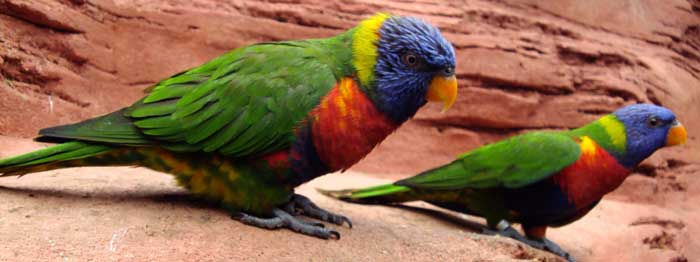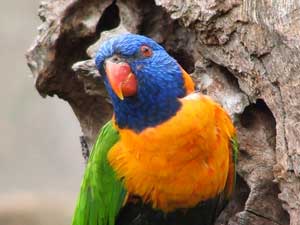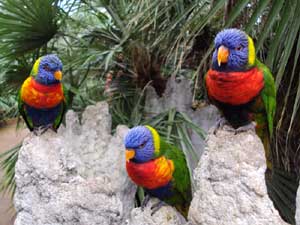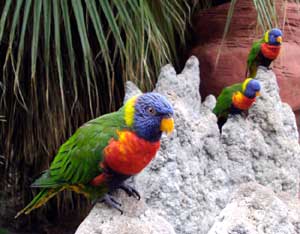 Accommodation | International
Flights | Domestic
Flights | Tours
| Travel
Insurance | Car
Hire | Visas
| Shopping
| Dating
| Humour
Accommodation | International
Flights | Domestic
Flights | Tours
| Travel
Insurance | Car
Hire | Visas
| Shopping
| Dating
| HumourRainbow lorikeet

The Rainbow Lorikeet, also known as Trichoglossus haematodus, is a species of Australasian parrot found in Australia, eastern Indonesia (Maluku and Western New Guinea), Papua New Guinea, New Caledonia, Solomon Islands and Vanuatu. In Australia, it is common along the eastern seaboard, from Queensland to South Australia and northwest Tasmania. Its habitat is rainforest, coastal bush and woodland areas. feeds on pollen and nector from flowers; they have specialised brush-tpped tongues and comparatively long, narrow bills. Some also regularily eat fruit.
The Rainbow Lorikeet is extremely colourful - almost every colour of the rainbow can be found on their feathers. They are not large birds, with a Rainbow Lorikeet's length ranging from 25–30 cm (9.8-11.8 in) in size, and have a wingspan of about 17 cm.
The features distinguishing a Rainbow Lorikeet include a dark blue or violet-blue head and stomach, a bright green back, tail and vent, and an orange breast and beak. Several subspecies have darker scalloped markings across the orange or red breast.
Rainbow Lorikeets often travel together in pairs and occasionally respond to calls to fly as a flock, then disperse again into pairs. Rainbow Lorikeet pairs defend their feeding and nesting areas aggressively against other Rainbow Lorikeets and other bird species. They chase off not only smaller birds such as the Noisy Miner, but also larger and more powerful birds such as the Australian Magpie.

Rainbow lorikeet
Photo by Bethwyn Boyt-Cullis
In many places, including campsites and suburban gardens, wild lorikeets are so used to humans that they can be hand-fed. Semi-tame lorikeets are common daily visitors in Sydney backyards, often by the dozens.
In Australia, breeding usually occurs during spring (September to December), but can vary from region to region with changes in food availability and climate. Nesting sites are variable and can include hollows of tall trees such as eucalypts, palm trunks, or overhanging rock. Pairs sometimes nest in the same tree with other Rainbow Lorikeet pairs, or other bird species.
Overall, the Rainbow Lorikeet remains widespread and often common. The status for some localized subspecies is more precarious, with especially T. h. rosenbergii being threatened by habitat loss and capture for the parrot trade.[
Rainbow Lorikeets orginally lived on the east coast of Australia but have been introduced to Western Australia.
The Rainbow Lorikeet was accidentally released into the southwest of the state of Western Australia from the University of Western Australia in the 1960s and they have since been classified as a pest. Rainbow Lorikeets can also be found in New Zealand, particularly around the Auckland area. New Zealand's Department of Conservation has declared them a pest and is using similar methods to control and eradicate them.
Many fruit orchard owners consider them a pest, as they often fly in groups and strip trees containing fresh fruit. In urban areas, the birds create nuisance noise and fouling of outdoor areas and vehicles with droppings.
HOME PAGE
Tourist Information
General Information
And Entertainment
ACCOMMODATION IN AUSTRALIA
Bed
& Breakfast
Budget
Accommodation
Backpackers Hostels
Hotels
in Australia
CAR HIRE IN AUSTRALIA
Australia Rental Cars
And
Campervans

TOURS
IN AUSTRALIA
What To Do In Australia
On-line
Shopping
On-line
Dating
![]()
About
Australia
Visas For Australia
How
To Get To Australia
How To Get Around
Travel Insurance
Travel Guides
Working
In Australia
Australian
Posters
Survival
Tips
Weather,
When To Go

Use of
this website constitutes acceptance of the User Agreement for this website
Contact us |
Advertise on this site
| Link to this site |Add
your photos or stories to this site |
Webmasters | Affiliates


